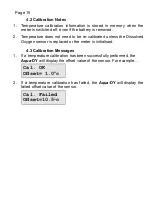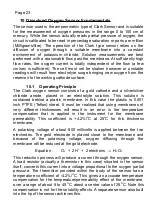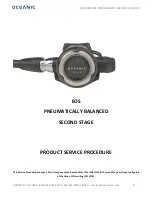
10.4
Notes On Units Of Dissolved Oxygen
The terms "Oxygen Concentration" and "Oxygen Partial Pressure"
frequently give rise to some confusion.
�
Oxygen Concentration is the absolute quantity of oxygen present per
unit mass of the liquid.
�
Oxygen Partial Pressure is the oxygen fraction of the total pressure of
all of the gases present.
For any one liquid system, Oxygen Concentration and Oxygen Partial
Pressure are proportional. However, if the solubility of oxygen in the liquid
should change owing to increased quantities of solutes, etc., then the
ratio of the Concentration to the Partial Pressure must change. Thus, if
one saturates distilled water and a 25% solution of Sodium Chloride with
air at atmospheric pressure (25
o
C) both solutions will have almost exactly
the same Oxygen Partial Pressure, namely 15.5 cm of mercury. However,
the dissolved Oxygen Concentration parts per million (milligrams per litre)
will be 8.2 in the distilled water and 2.01 in the salt solution. This is a
rather extreme example, as ocean water is only 3.6% saline. It does
however stress the importance of correct interpretation of the salinity.
The Clark Sensor measures the partial pressure of oxygen diffusing
through a membrane. The current is a linear measure of this partial
pressure, assuming sufficient liquid flow conditions.
With air at sea level, the 20.9% oxygen exerts about 15.5 cm of Mercury
pressure. Water in equilibrium with air and with no oxygen demand
(C.O.D., B.O.D. etc.), is saturated and has this dissolved oxygen partial
pressure. If we define 100% Saturation in Partial Pressure terms, then
15.5 cm. Hg = 100% Saturation. This is a practical unit to use. The sensor
readout is then a linear function of % Saturation. Organic cell walls and
the Dissolved Oxygen sensor behave in the same way, so % Saturation
units are a more meaningful measure of the Dissolved Oxygen
requirement of biological organisms (eg fish).
% Saturation is the best unit for industrial control and not ppM, contrary to
popular beliefs. The partial pressure (and consequently the pressure
defined % Saturation) varies only slightly with temperature. (Recall at this
stage that the permeability of the membrane has a temperature
coefficient, but the electronics has scaled this out by the operation of the
Automatic Membrane Temperature Compensator Thermistor incorporated
in the D.O. sensor).
Page 25



































